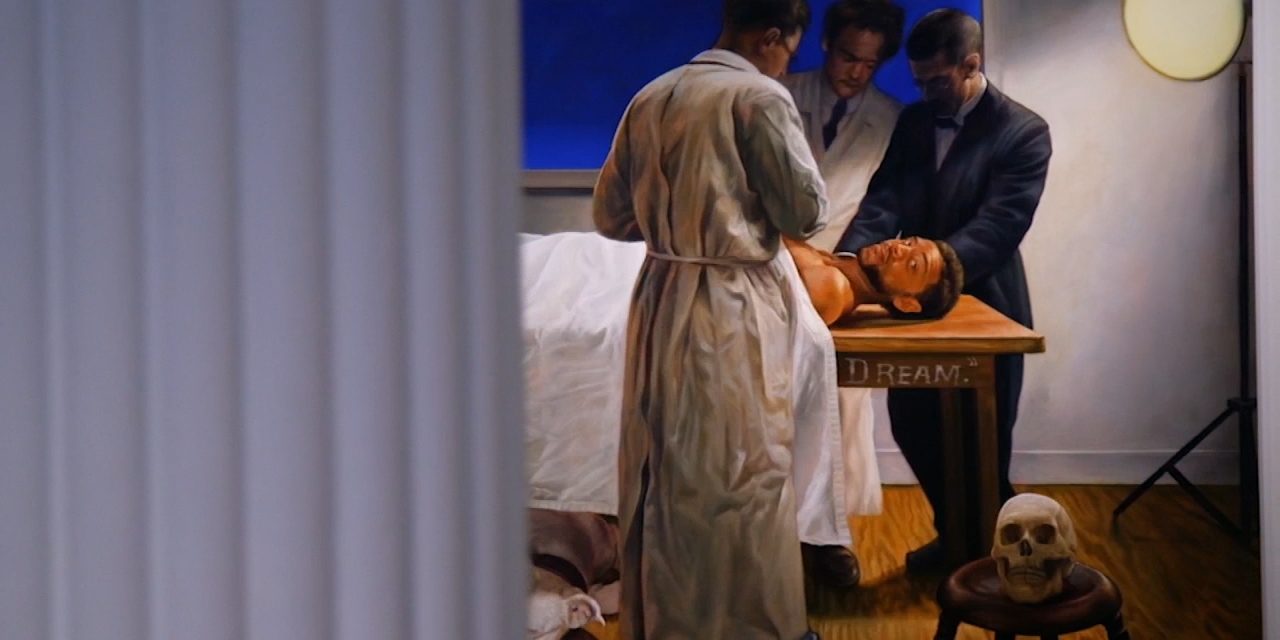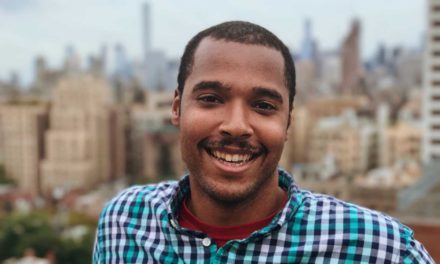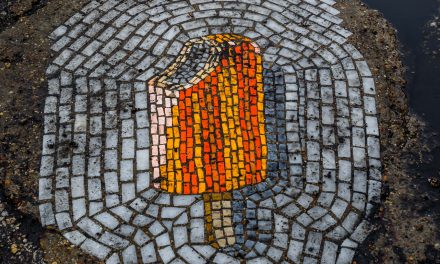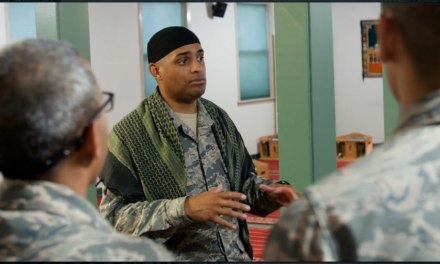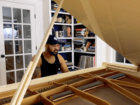It wasn’t until artist Mario Moore had brain surgery that a singular question arose in his mind: can Black men truly rest? The One Detroit Arts & Culture team caught up with silverpoint artist and muralist at the David Klein Gallery to explore the meaning behind his latest exhibition entitled ‘Recovery‘
DJ Oliver: [00:00:00] What’s up guys. And welcome to the eighth season of Detroit Performs. This season we’re going to hit you up with an array of different artists including play sculptors, graffiti jewelry makers, classically trained musicians, vogue dancers, and so much more. But tonight we are here at the David Klein Gallery kicking things off with a silver point artist and muralist who asked the question in his latest exhibition, ‘Is it possible for us to truly rest’? Here is Mario Moore.
Mario Moore: [00:00:39] I’m interested in creating the stage that the audience can kind of come into.
[00:00:49] Art, to me, he has always been involved in my life. I grew up around the DIA. [00:00:53] I used to go visit the museum when I was a kid. I would walk through the galleries but as far as like inspiration that came from my mom Sabrina Nelson because you know she I would see her do these large paintings. [00:01:04] Just the idea to look at a canvas as blank or a piece of paper and her just like make something was always interesting to me. [00:01:12] The way that I begin my work is usually through sketches and ideas. It’s usually that I have a thought and I have a process and I sketch out or I think about that thought and I say what is the best way to portray this thought or to talk about this idea. So that can go to sculpture, that can go to drawing, that can go to video that can go to a painting, but the majority of the time, I’m interested in like a massive narrative. [00:01:38] We’re in the David Klein Gallery, and the show is called ‘Recovery’. [00:01:42] And the show is about considering how black men rest and relax and take time for themselves. [00:01:50] What happened was I was working on a body of work where I was thinking about myself personally and how I move my body through the world and how the world considers me as a black man. And then, I had brain surgery. [00:02:03] I had brain surgery and literally, I was forced to rest so that that made me think about things historically. Like how did historic black men that we know we know and the world knows–like Martin Luther King or Malcolm X or W.E.B. Dubois and when we look up their names are always speaking really loud. They’re on the podium. They’re always active. Like in times of turmoil like what we’re dealing with today as far as everything politically and socio-economically how do I rest. [00:02:36] Because we’re kind of in a we’re in a similar state, and in some ways, in some senses as far as education and things like that it’s it’s worse it’s gone backwards instead of forwards. So, but at the same time, we’re human. So these men took vacations. They took time with their family. They took naps. So I started to think about that and the work presents a question because I don’t have the answer. So how do black men rest? How did they relax, and what does that look like? [00:03:04] Has to do with just the history of America. In that black men and black people just in general, we’re in the process of constantly having to stay ahead. Right. Just to catch up economically. Since we got to the country of the Americas, we were slaves you know we were it was it was things that the country were were built on the labor that we put in. [00:03:26] So that is passed down as far as trying to catch up. You have to work extremely hard. So the idea of resting or relaxing is not a part of the process when you’re always thinking about what do I need to do next. [00:03:42] Silver point is a technique that was used in the 16th and 15th century and it’s literally a piece of silver and drawing with a piece of silver. [00:03:51] Most of the silver point drawings that have the historical like the large ones that have historical figures in the background. It’s a concept an idea is that can a black man look relaxed and calm and present himself in that way but also at the same time be powerful. Like I’m letting the background you know the historical figures do all the work for me while I relax and I think that’s part of the importance and then part of the process. [00:04:21] I like the amount of texture and detail that went into this over point but there’s a limited number of values that you can reach. So no matter what I draw no matter how hard the subject matter is it’s always going to be this softness to it. And I really like that. The other thing I really like about silver point is that you can’t erase. [00:04:38] So it’s almost like drawing with a pen like whatever you put down is permanent. So so everything that goes into that drawing you have to deal with it, right? It’s there to exist forever. Another thing I like is that in dealing with silver point you’re literally leaving behind silver on paper. So you’re creating something that has initial value and with the work that I was working on, I’m dealing with the subject matter that people don’t see as valuable. America often sees as in value as far as black men. And also this idea of rest this idea of relaxing. So I think that material has worked for me really well and thinking about these ideas and concepts. [00:05:24] There’s one piece in particular in the show. I read this book called Medical Apartheid. It has to do with the experimentation on black people from slavery to contemporary times. And I also got this huge photography book called Stiffs, Skulls, and Skeletons. Through that book you can see how they, like, experimented and practiced on cadavers and the most cadavers you will see are black or African-American cadavers. And the way that that happened is there were like well we don’t really care about this community so we can dig up these graves and use these bodies. So those bodies became objects they weren’t even people anymore. So it was like, well, that thing that just happened to me with my brain surgery what would it look like, you know, back in these times and I wanted to show opposition to that that shine the light on me as a person as a human being instead of an object and kind of like mute the light on the figures that are above me. [00:06:21] The American Bulldog. For me it’s a literal representation of the history of America. And I use it as a symbol for America itself. And often you’ll find the dog is sleeping or relaxing as it’s ignoring the big issues that are happening right above it. I include history in my work because, as far as social issues, we kind of roll around all the time back to similar issues over and over again. So I look at the past and I consider it and I’m saying well what was happening then kind of looks like now. [00:06:55] What did they do then. What can we do now. What can we do to change it. And what does that look like. [00:07:02] I think there’s a ton of stuff to take away from this show. [00:07:04] I think about a lot of different narratives that go into one piece but there’s a lot of stuff that I don’t think about. And I think those are the important things that people that come and see the show they can pull out for themselves. I think it’s important for the people to answer. [00:07:19] Well, these are the things that I’ve noticed. These are some ideas that I’m thinking about. This is a question that I have and I think it becomes more participatory that the people that come and see the show, they provide the answers. [00:07:31] I think hearing their perspective and hearing their ideas about resting and what that looked like for them was extremely important. I think hearing my dad talk about how he’s worked since he was 16 years old and talking about his perspective was important. But I think the most important thing that happened after the show was I went into the barbershop and one of the barbers that was in there he told me after seeing my show he literally took a week off work. And then also hearing that several men, you know after seeing the show, were going outside and crying. You know, which is like like, that that they honestly never thought in this way. So I think those were probably the most important things that happened.DJ Oliver: [00:08:19] You can learn more about Mario Moore as well all the artists that we feature on DetroitPerforms.org.

